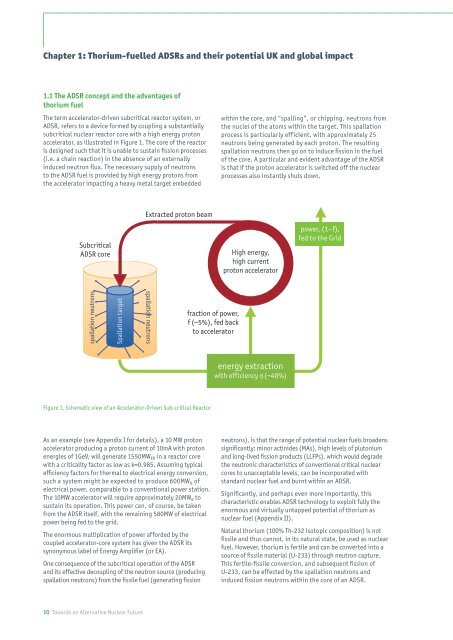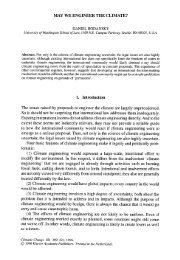ThorEA - Towards an Alternative Nuclear Future.pdf
ThorEA - Towards an Alternative Nuclear Future.pdf
ThorEA - Towards an Alternative Nuclear Future.pdf
Create successful ePaper yourself
Turn your PDF publications into a flip-book with our unique Google optimized e-Paper software.
Chapter 1: Thorium-fuelled ADSRs <strong>an</strong>d their potential UK <strong>an</strong>d global impact<br />
1.1 The ADSR concept <strong>an</strong>d the adv<strong>an</strong>tages of<br />
thorium fuel<br />
The term accelerator-driven subcritical reactor system, or<br />
ADSR, refers to a device formed by coupling a subst<strong>an</strong>tially<br />
subcritical nuclear reactor core with a high energy proton<br />
accelerator, as illustrated in Figure 1. The core of the reactor<br />
is designed such that it is unable to sustain fission processes<br />
(i.e. a chain reaction) in the absence of <strong>an</strong> externally<br />
induced neutron flux. The necessary supply of neutrons<br />
to the ADSR fuel is provided by high energy protons from<br />
the accelerator impacting a heavy metal target embedded<br />
Subcritical<br />
ADSR core<br />
Extracted proton beam<br />
Figure 1. Schematic view of <strong>an</strong> Accelerator-Driven Sub-critical Reactor<br />
As <strong>an</strong> example (see Appendix I for details), a 10 MW proton<br />
accelerator producing a proton current of 10mA with proton<br />
energies of 1GeV, will generate 1550MWth in a reactor core<br />
with a criticality factor as low as k=0.985. Assuming typical<br />
efficiency factors for thermal to electrical energy conversion,<br />
such a system might be expected to produce 600MWe of<br />
electrical power, comparable to a conventional power station.<br />
The 10MW accelerator will require approximately 20MWe to<br />
sustain its operation. This power c<strong>an</strong>, of course, be taken<br />
from the ADSR itself, with the remaining 580MW of electrical<br />
power being fed to the grid.<br />
The enormous multiplication of power afforded by the<br />
coupled accelerator-core system has given the ADSR its<br />
synonymous label of Energy Amplifier (or EA).<br />
One consequence of the subcritical operation of the ADSR<br />
<strong>an</strong>d its effective decoupling of the neutron source (producing<br />
spallation neutrons) from the fissile fuel (generating fission<br />
10 <strong>Towards</strong> <strong>an</strong> <strong>Alternative</strong> <strong>Nuclear</strong> <strong>Future</strong><br />
fraction of power,<br />
f (~5%), fed back<br />
to accelerator<br />
within the core, <strong>an</strong>d “spalling”, or chipping, neutrons from<br />
the nuclei of the atoms within the target. This spallation<br />
process is particularly efficient, with approximately 25<br />
neutrons being generated by each proton. The resulting<br />
spallation neutrons then go on to induce fission in the fuel<br />
of the core. A particular <strong>an</strong>d evident adv<strong>an</strong>tage of the ADSR<br />
is that if the proton accelerator is switched off the nuclear<br />
processes also inst<strong>an</strong>tly shuts down.<br />
High energy,<br />
high current<br />
proton accelerator<br />
energy extraction<br />
with efficiency (~40%)<br />
power, (1- f),<br />
fed to the Grid<br />
neutrons), is that the r<strong>an</strong>ge of potential nuclear fuels broadens<br />
signific<strong>an</strong>tly: minor actinides (MAs), high levels of plutonium<br />
<strong>an</strong>d long-lived fission products (LLFPs), which would degrade<br />
the neutronic characteristics of conventional critical nuclear<br />
cores to unacceptable levels, c<strong>an</strong> be incorporated with<br />
st<strong>an</strong>dard nuclear fuel <strong>an</strong>d burnt within <strong>an</strong> ADSR.<br />
Signific<strong>an</strong>tly, <strong>an</strong>d perhaps even more import<strong>an</strong>tly, this<br />
characteristic enables ADSR technology to exploit fully the<br />
enormous <strong>an</strong>d virtually untapped potential of thorium as<br />
nuclear fuel (Appendix II).<br />
Natural thorium (100% Th-232 isotopic composition) is not<br />
fissile <strong>an</strong>d thus c<strong>an</strong>not, in its natural state, be used as nuclear<br />
fuel. However, thorium is fertile <strong>an</strong>d c<strong>an</strong> be converted into a<br />
source of fissile material (U-233) through neutron capture.<br />
This fertile-fissile conversion, <strong>an</strong>d subsequent fission of<br />
U-233, c<strong>an</strong> be effected by the spallation neutrons <strong>an</strong>d<br />
induced fission neutrons within the core of <strong>an</strong> ADSR.



